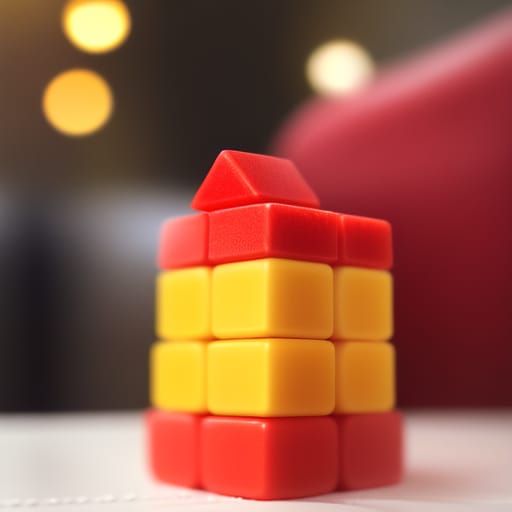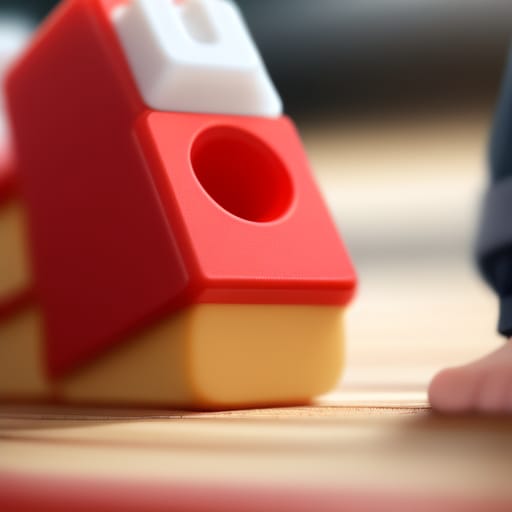Giant soft building blocks are quickly becoming a staple in preschool classrooms, daycares, and playrooms everywhere. Compared to smaller, traditional blocks, these oversized, lightweight blocks allow children to build on a grander scale, exploring their creativity through larger structures and designs.
With so many options on the market, it can get confusing trying to select the right sets of blocks for your kids. This beginner’s guide will walk you through everything you need to know about buying the best large soft blocks for toddlers and young children.

What Are Large Soft Building Blocks?
- Definition: Large soft building blocks are oversized, lightweight blocks made from soft foam or fabric materials that allow children to build large structures. They are much bigger than standard wooden blocks or LEGOs.
- Typical sizes: Blocks range from around 12-30 inches in size. Many sets feature rectangular and square blocks in varying sizes and shapes like triangles, pillars, arches, and ramps.
- Materials: Blocks are usually made from soft, lightweight EVA foam or a polyester fiber fill encased in a velour fabric. Some also have a waterproof nylon cover for easy wiping.
Compared to smaller blocks, these lightweight and easy-to-grip giant blocks with soft, rounded corners allow for more creative building on a larger scale. Plus, they’re durable, washable, and safer for younger kids.
Key Characteristics of Large Soft Blocks
From vivid colors to special shapes, each set of blocks has unique characteristics. Here’s what to look for when comparing options:
Size and Shape
- Block sizes range from around 1-2.5 feet per block
- Shapes include squares, rectangles, triangles, columns, arches, and ramps
- Having multiple sizes and shapes in one set allows for more building creativity
| Type of Block | Average Size | Typical Weight |
|---|---|---|
| Basic square blocks | 12-18 inches | Under 1 lb |
| Large rectangle blocks | Up to 30 inches | 1-3 lbs |
| Triangles | 15-inch sides | Under 1 lb |
| Columns | 20 inches tall | Around 2 lbs |
| Arches | 25 inches tall | Around 3 lbs |
Materials and Texture
- Most feature a soft, pliable EVA foam interior. Some have 100% polyester fiber fill.
- Covered in stretchy, textured velour or soft silk that’s easy to grip
- Waterproof nylon covers allow for quick wiping and cleaning
- Bright colors and appealing textures inspire tactile exploration
Trying out samples of different material types allows you to assess properties like durability, washability, and grip.
Key Benefits of Using Oversized Soft Blocks
The larger scale, lightweight nature, stability, and versatility of these building toys have many developmental upsides compared to traditional blocks.
Encourage Physical Development
- Gross motor skills: Lifting, carrying, stacking larger blocks
- Hand-eye coordination: Placing shapes and patterns
- Balance and stability: Assembling larger structures kids can stand/walk on
Little ones stay active and build strength manipulating these fun soft “construction” materials.
Enhance Cognitive Growth
- Spatial reasoning and depth perception: Visualizing and creating large designs
- Problem-solving skills: Critical thinking to build stable structures
- Shape, color and pattern recognition: Identifying differences in blocks
As kids test concepts of balance, proportion and gravity, it builds their spatial reasoning abilities.
Foster Social-Emotional Skills
- Communication and collaboration: Group block play encourages teamwork
- Confidence and resilience: Creative experimentation in low-stakes environment
- Emotional regulation: Focusing on constructive activity calms anxiety
The cooperative creative process helps children self-regulate emotions as they share ideas.

Using Oversized Blocks in Classrooms
Giant soft blocks have become a staple in early childhood and special education settings due to their versatility:
Preschool and Daycare Settings
- Block stations teach STEM/building fundamentals across learning domains
- Open-ended loose parts play develops executive functioning
- Lightweight blocks accessible for mixed age groups
- Easy to incorporate into small group lessons or centers
- Promote safe social interactions and play skills
Structured lessons as well as freeform creative play with these classroom-friendly blocks builds cognitive, motor and social emotional skills.
Special Education Environments
- Sensory-rich, soft texture appeals to tactile learners
- Colors/patterns can teach sorting/classification
- Adaptable for children with special needs; extra stability helps those with motor delays
- Encourages nonverbal communication and cooperation
- Can help channel “sensory-seeking” stimming behaviors
This versatile material keeps special needs kids meaningfully engaged, promoting critical developmental skills.
Home Use
Parents and caregivers can also foster learning at home:
- Strengthen parent-child bonding through cooperative play
- Practice counting, colors, shapes and patterns during imaginative games
- Develop oral language and vocabulary having kids describe their structures
- Make basic STEM concepts part of daily life
- Channels boisterous energy into constructive activity
With a little guidance, block play will teach core skills and nurture your child’s development.
Most Popular Brands of Oversized Blocks
We’ll now compare top options available at stores and online. These featured brands for giant blocks strike a balance of quality, safety, durability and affordability.
Kaplan Early Learning Company
Known for their educational toys and classroom supplies, Kaplan’s plush oversized building blocks earn rave reviews for quality and durability.
- Blocks made with soft padded polyester fiber fill covered in velour fabric
- 5” – 7” thickness makes these blocks remarkably stable for tall structures
- Vivid colors appeal to young kids
- Lightweight and easy to clean
- Range of block shapes and accessory pieces promote creativity
- Parents love the durability over years of use
- Used in classrooms as well as at home
With glowing feedback on how “indestructible” these blocks are, Kaplan is a top choice for long-lasting oversized blocks across various settings.
Wayfair Building Blocks
This popular home goods store carries affordable own-brand giant block sets that don’t skimp on quality or versatility.
- Thick, soft foam covered in plush velour in fun, bright colors
- Blocks range from 5-18 inches in various shapes and sizes
- Sets can include activity accessories like alphabet tiles or storage bags
- Hundreds of 5-star customer reviews
- Budget-friendly price point around $50 for a 20+ piece set
- Designed for children 10 months up to 5 years
Wayfair makes it easy to get a feature-packed starter set of soft oversized blocks at everyday value prices.
Lakeshore Big Building Blocks
Specializing in early childhood educational toys for over 50 years, Lakeshore’s beloved extra-large foam blocks inspire imagination.
- Made of light, durable foam covered in soft easy-grip fabric
- Sets range from 18 up to 36 blocks in multiple colors/designs
- Tons of add-ons like wheels, pulleys, letters available
- Rave reviews from teachers on durability and versatility
- On par price-wise with other top brands
- Easy to incorporate into lesson plans with guidebook included
- Recommended for 12 months up to 6 years
With superior classroom performance reviews and endless accessory options, Lakeshore blocks stimulate creativity and skill-building during play.
Amazon Basics Soft Infant Blocks
For wallet-friendly starter sets, Amazon’s own affordable basics line has plenty of parent-approved options:
- Lowest cost sets with prices from $13 for 14 up to 42 blocks
- Made of light, chunky foam blocks covered in silky soft fabric
- Vibrant colors and fun nature/animal patterns
- Hundreds of positive reviews praise softness and easy gripping
- Light enough for toddlers to maneuver
- Recommended ages from 6 months up to 5 years
As a budget-saver for babies and tots needing fewer or simple starter blocks, Amazon makes for a solid choice.
Beyond the major retailers, many other excellent kid’s toy brands offer quality foam blocks in various price tiers. Trying out sample blocks first can help assess traits like texture appeal and sturdiness.
Key Safety Tips for Children and Block Use
While oversized foam blocks provide a safer building option over hard materials, their lightweight nature still poses some risks, especially to toddlers. Follow these tips for safe play:
- Always supervise young children during block play, especially with structures over shoulder height.
- Show children how to properly carry blocks; don’t let them run while holding.
- Set reasonable limits on structure height to prevent toppling over.
- Ensure solid, level stacking to avoid unstable towers that may crash down.
- For children under 3 years, limit block play to simple stacking and patterns.
- Beware of small parts detachable from certain letter/number block sets that could pose a choking hazard.
With precautions and adult guidance, blocks offer low-risk construction fun. But ultimately an adult should monitor for sound structural engineering!
Cleaning and Storing Giant Blocks
Major benefits of soft blocks are their wipeability and washability. Here is how to maintain them:
- Spot clean velour fabric covers with warm soapy water or gentle soap and rinse cloth
- Foam interiors can even go in the washing machine on cold gentle cycle then air dry
- Alternately let air dry overnight after handwashing
- Every month or so disinfect with diluted bleach or antibacterial spray
- Cedar blocks help absorb odors for storage bins
- Rotate accessories to keep play novelty high
Proper cleaning and storage will keep soft blocks looking and smelling like new for years of enjoyment.

The Many Benefits of Giant Construction Blocks
Giving young learners jumbo building materials opens up a world of imagination and educational play. Well-designed soft blocks will:
- Stimulate creativity through more versatile structures
- Build physical skills from infant fine motor all the way to core stability
- Allow cooperative, communication-based play experiences
- Lay early STEM foundations like spatial reasoning
- Provide children of all ability levels an open-ended tactile outlet
With hundreds of sets to choose from, focus on quality over quantity; a few dozen good starter blocks will deliver limitless play. Developing minds will construct memories alongside mega block towers!
Frequently Asked Questions
What age are giant soft blocks appropriate for?
These oversized building toys are designed for children typically between the ages of 6 months and 6 years old. Look for sets marked for specific age ranges based on size, weight, and small parts that could pose safety hazards. Many blocks work well across age groups.
How many large blocks should I get?
For young toddlers, a set of 20-30 blocks with some variant shapes and sizes is ideal. As kids get older, expand to 40-50 pieces for more complex structures. Accessory add-ons like wheels, pulleys and letters promote open-ended play possibilities too.
Which blocks are best for classroom use?
Opt for thicker soft foam classroom blocks rated for heavy use, like Kaplan or Lakeshore brands. Durable, washable materials that hold up to daily use and abuse are key.having a storage method like bins or shelves helps maintain order when sharing between groups.
Can blocks help children with special needs?
Yes, the lightweight design, vibrant colors and soft textures appeal to a broad range of learning styles and abilities. Occupational therapists often use giant blocks to encourage gross motor skills, spatial reasoning skills, social interactions and sensory processing play.
Why are bigger blocks better than small wooden blocks?
The larger scale enables exploring more advanced engineering concepts for older kids, while still being easy for small hands to manipulate. The soft texture provides more grippability for little hands and more stability, so even towering structures are safer for active play.
How do you incorporate STEM learning with blocks?
Use blocks to demonstrate real-world physics concepts like gravity, balance, and geometry. Guide play with challenges asking kids to build structures to meet size specs that require spatial planning. Ask open-ended questions about what makes structures sturdy or how to prevent collapse.
Are soft blocks only for indoor use?
Many feature waterproof nylon covers, but thick foam can still absorb water over time in damp conditions. Storing blocks properly indoors will maximize longevity. You can use outdoors on dry days, but clean promptly after.